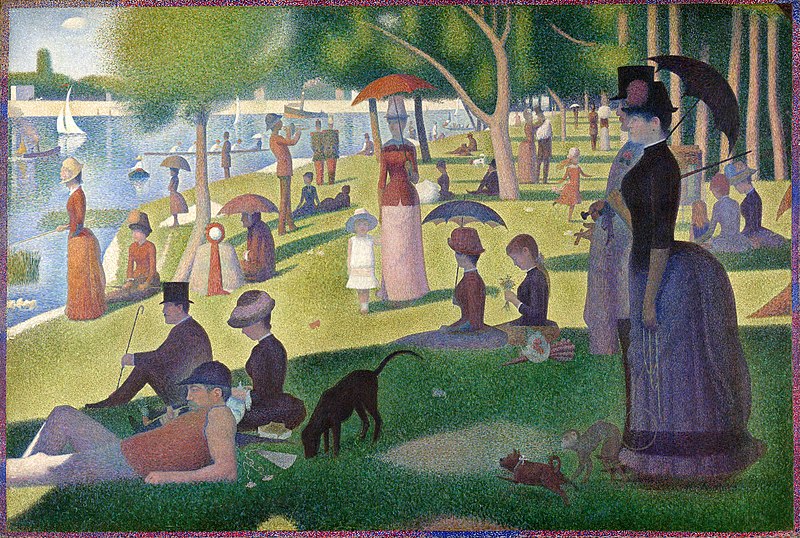
Source: https://en.wikipedia.org/wiki/File:Baigneurs_a_Asnieres.jpg
The
painting that I’ve chosen is Bathers at
Asnières, by Georges Pierre Seurat. It was painted in 1884 and in that year he submitted it to the jury of the Official Salon, but the jury rejected
it. After that it was presented in the Salon des Indépendants. It’s
an oil painting on canvas and its dimensions are 201 cm × 300 cm. At the moment this painting is located in
the National Gallery in London.
In this
painting we can see a group of people on the bank of a big river. It has beautiful colours predominate in the clothes, in the grass, in the
sky... In the background we see big factories in crayon colours. There are also
two children in the river, they are playing with the water. And the rest of the
people are observing the landscape. I can also see a small dog next to someone.
I suppose it belongs to that person. They are lying and sitting down on the
grass, I suppose observing the opposite bank. They are wearing simple clothes
like white t-shirts, black trousers… The expressions of their faces are simple and serious, as if their
lives didn’t have any
meaning.
In the
spring of 1883, young Georges Seurat exhibited his first monumental composition,
The Bathers at Asnières. Unlike Auguste Renoir and
others, who created fetching groups of naked female bathers enjoying in an Arcadian nature, Seurat chose to represent a diverse
group of working-class males on an unpicturesque stretch of the Seine near the
industrial landscape of Clichy.
Seurat
wanted to represent in this painting the beautiful season of summer in the
riverside of a big French river called Seine, where people went to spend the
day. He represented this with a blue sky, with grass and, of course, dressing the people with summer clothes, like short pants, hats, shirtless people and so on. He also painted trees
that provide shade to people and in the background of the painting we can see some factories and buildings in light colours.
His
painting was painted in a small studio in the rue Chabrol. Before
doing the definitive paintings, Seurat did
sketches in small dimensions and he put them on the wall of his small studio. He used Conté
crayon to work out means of deploying light and shade for the purpose of
implying space and plasticity. At the same time Seurat studied at the École. These experiences helped Seurat
to emerge from the discipline of the École, and to cause him to
fashion his own distinctly modern method of applying paint and using tone and
colour. He immersed himself in the writings and ideas of other aesthetic
theoreticians such as David Sutter, the
chemist Michel Eugène Chevreul and the
physicist Ogden Rood, and with the painting of the Bathers he
borrowed heavily their ideas about colours and the way humans perceive
them.
These are
possible preparatory sketches
for the Bathers:

![Georges SEURAT | Study for 'Bathers at Asnières' [Etude pour 'Une baignade à Asnières']](http://nga.gov.au/exhibition/masterpiecesfromparis/Images/400/191249.jpg)
Seurat
spent much of his early years painting workers. Initially he planned to do the
same in the Bathers, depicting horses
being bathed in the river by stable boys. In
this study, the suggestion of labour was replaced by a scene of pure leisure,
featuring just human figures. The working or lower-middle class shown relaxing
on the bank have no direct reference to the industry behind them.
Bathers at Asnières had also identical size to the painting A Sunday Afternoon on the Island of La
Grande Jatte, which represented the right bank of the river. This painting
was painted in 1883. He wanted to represent the class-based society. On A Sunday
Afternoon on the Island of La Grande Jatte (the right bank) he represented the
bourgeoisie and on Bathers at Asnières (the left bank) he painted the working class
people.

The Bathers are cast in light, while on the Grande Jatte people are mostly in shadows
and there are some symbols of lust, like a woman with a monkey on a leash, and
prostitution, like a woman fishing. And Seurat also wanted to express that the working class people said
to the bourgeoisie that they were the future and the bourgeois had to come and
join them.
Georges
Pierre Seurat was a French Neo- Impressionist painter. His drawings were mainly
made with the technique of pointillism. But the Bathers was painted
on oil on canvas because he hadn’t invented pointillism yet,
but he later reworked some areas of this painting to create contrasts of colour in some parts.
His work of A Sunday Afternoon on the Island of La
Grande Jatte altered the direction of art and created Neo- Impressionism. His main paintings were:

La Parade ( 1889) The Eiffel Tower (1889)

The Seine At La Grande Jatte. Springtime (1888)

Gray weather, Grande Jatte, (1888)

The Seine at Courbevoie (1885)
I like this painting because it´s really colourful,
the expression of the people (once you know the meaning), their costumes are
very good, properly from the working class people (the left bank of the river)
and of course I like the technique.
Sources:
https://en.wikipedia.org/wiki/Bathers_at_Asni%C3%A8res
https://en.wikipedia.org/wiki/Bathers_at_Asni%C3%A8res#Aesthetic
https://en.wikipedia.org/wiki/Bathers_at_Asni%C3%A8res#Reception_and_history
http://www.buscabiografias.com/bios/biografia/verDetalle/131/Georges%20Seurat%20-%20Georges%20Pierre%20Seurat
https://www.google.es/search?tbm=isch&source=univ&sa=X&ei=qrJ7UbeTAdGXhQfS_YCIBA&ved=0CDYQsAQ&biw=1280&bih=591&q=paintings%20of%20georges%20pierre%20seurat
http://www.artic.edu/aic/resources/resource/411
http://www.nationalgallery.org.uk/paintings/georges-seurat-bathers-at-asnieres
http://www.webexhibits.org/colorart/pointillism.htmlhttp
1 comment:
Hello Isabel,
Your final mark is 8.5. You forgot to erase some of my corrections. I've just erased them. See you!
Post a Comment